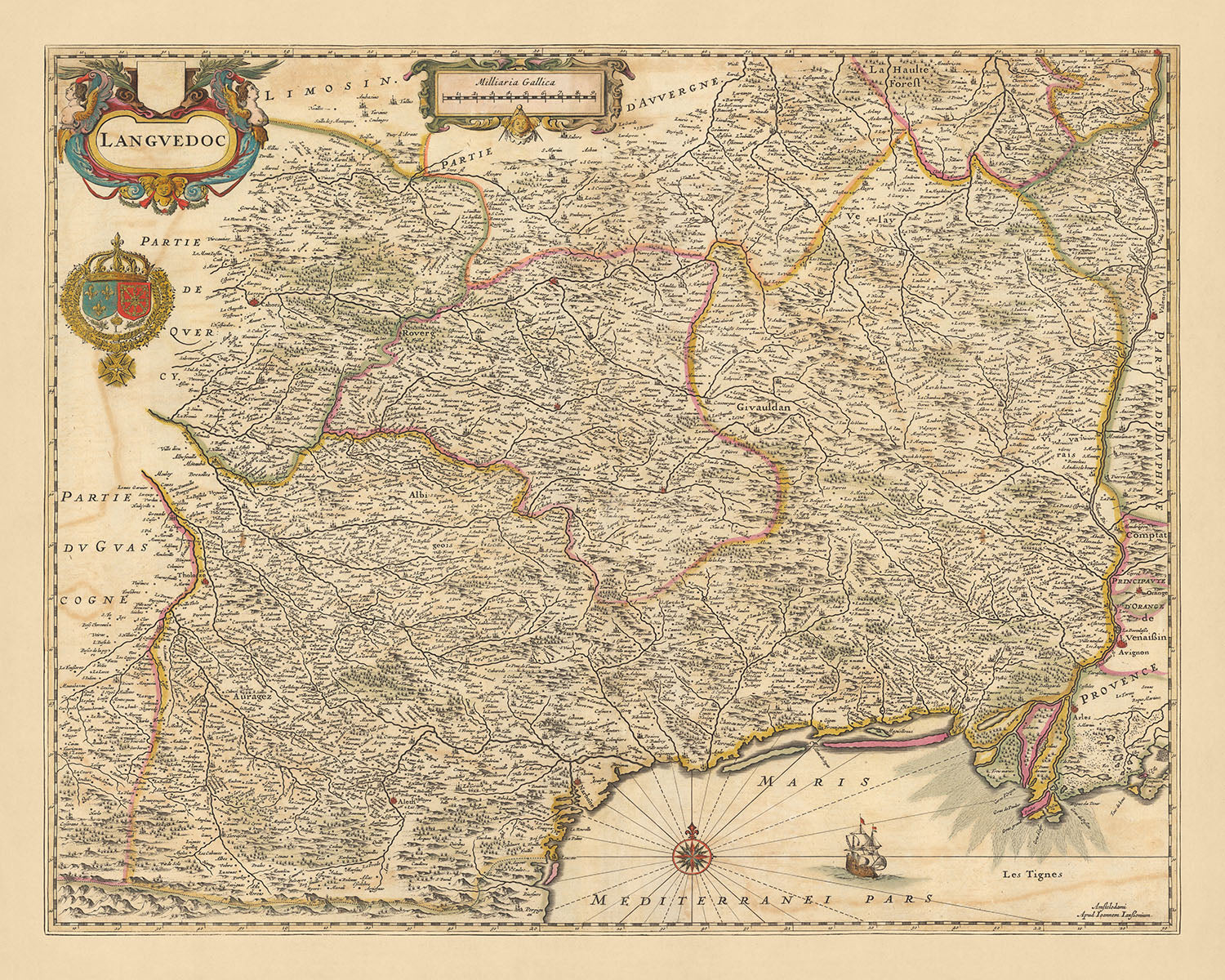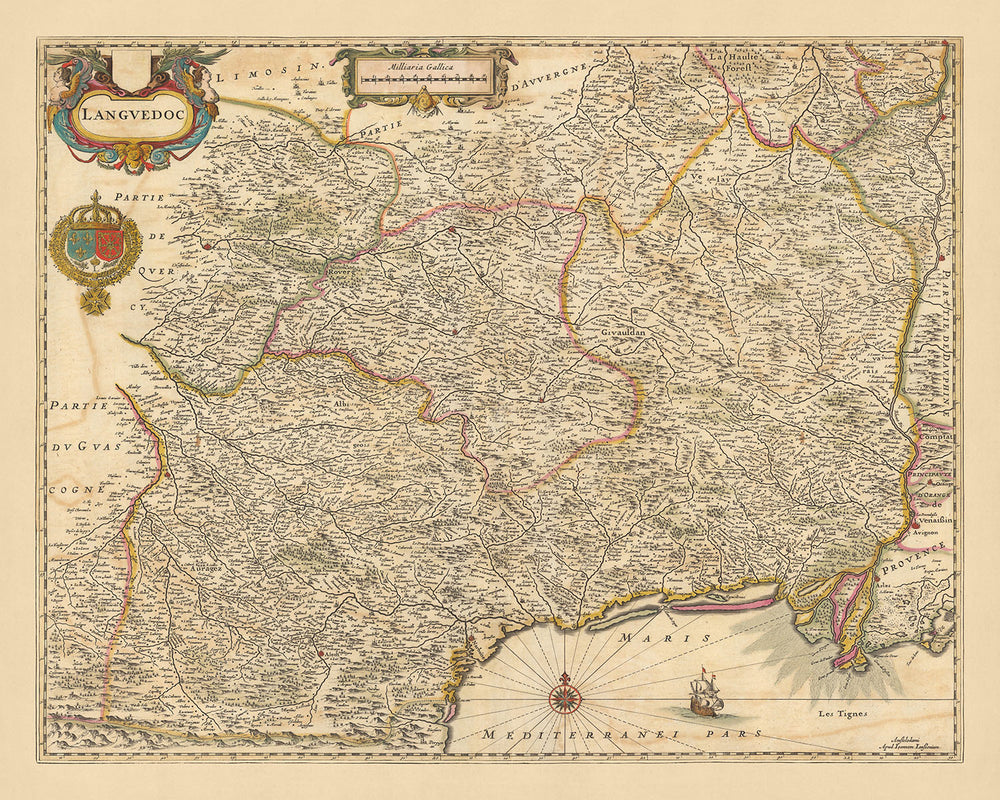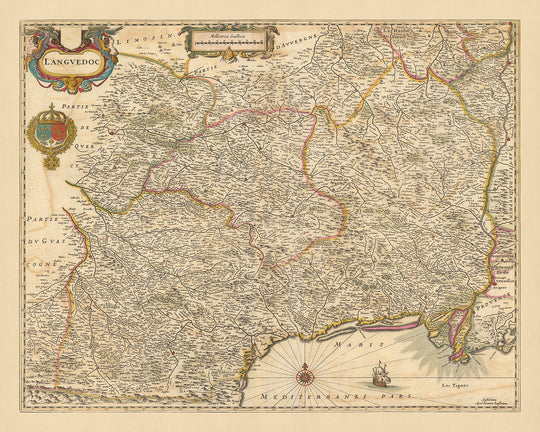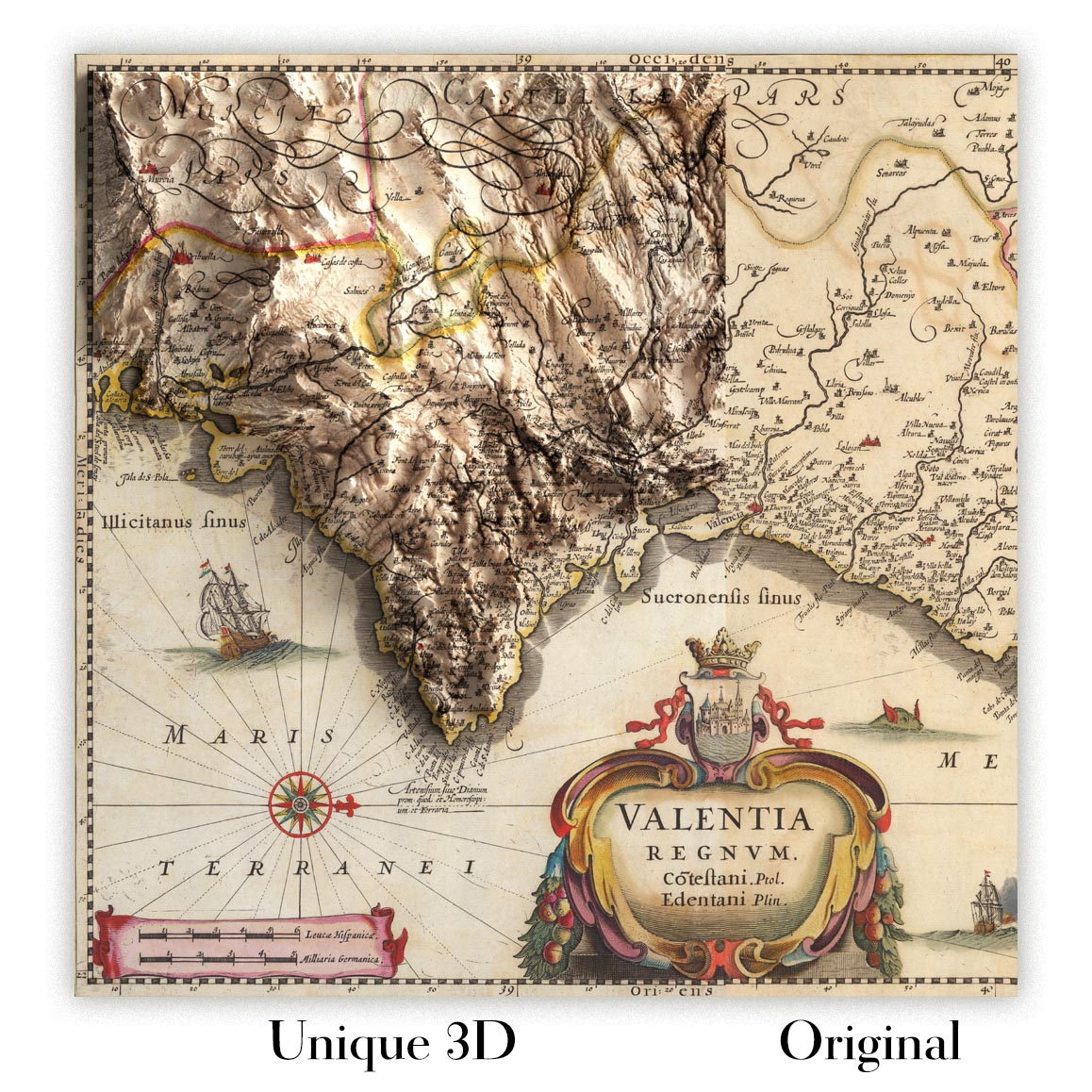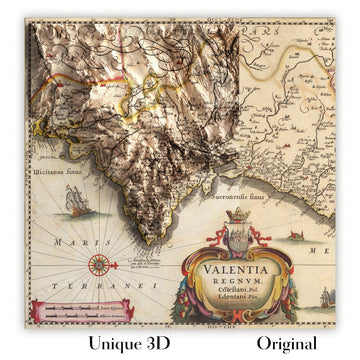- Handmade locally. No import duty or tax
- FREE Delivery by Christmas
- Love it or your money back (90 days)
- Questions? WhatsApp me any time
Own a piece of history
5,000+ 5 star reviews


Discover the rich history and intricate beauty of 'Languedoc', a stunning map crafted by the skilled hands of Nicolaes Visscher II in 1690. As a prominent figure in the Dutch Golden Age of cartography, Visscher's work is a testament to the precision and artistry of this era. This map, focusing on the Province of Languedoc in France, offers a glimpse into the political and geographical divisions of the time. The name 'Languedoc' translates to 'Language of Oc', referring to the Occitan language spoken in this southern region of France.
Notable cities highlighted on this map include Toulouse, Montpelier, Perpignan, and Avignon. Each city holds its own historical significance, from Toulouse, known as the 'Ville Rose' for its distinctive brick architecture, to Perpignan, a city rich in Catalan culture. The map also features the Cévennes National Park, a rugged wilderness area that is a testament to the diverse natural beauty of France.
The map is hand-colored in outline, a technique that adds depth and dimension to the detailed engravings. It showcases a variety of geographical features such as forests, waterways, canals, and mountains. The administrative boundaries are clearly marked, providing a clear understanding of the political landscape of the time. The decorative cartouches, coat of arms, compass rose, and rhumb lines add an artistic flair that elevates this map beyond a mere geographical tool.
The relief of the map is shown pictorially, offering a unique perspective of the terrain. The use of color and shading provides a visual guide to the topography of the region, from the rolling hills to the towering mountains. This map is not just a piece of history, but a work of art that captures the essence of Languedoc. It is a testament to the craftsmanship of Nicolaes Visscher II and a unique opportunity to own a piece of the past.
Some of the significant locations shown on this map:
Languedoc Region
- Toulouse: Known as the 'Ville Rose' for its distinctive brick architecture, it was a major city of the Roman Empire.
- Montpellier: Founded in the 10th century, it was known for its university, one of the oldest in the world.
- Nîmes: Known in Roman times as Nemausus, it has a well-preserved Roman amphitheater.
- Béziers: Known for the Béziers Massacre during the Albigensian Crusade in the 13th century.
- Narbonne: A key Roman port and a major city during the Middle Ages.
- Carcassonne: Known for its fortified city, a UNESCO World Heritage Site.
- Albi: Known for the Albi Cathedral and the birthplace of famous painter Toulouse-Lautrec.
- Castres: Known for its houses on the Agout river, often compared to Venice.
- Mende: The capital of the Gevaudan region, known for its cathedral.
- Rodez: Known for its Gothic cathedral and Fenaille museum.
- Cahors: Known for its medieval bridge, the Pont Valentré.
- Millau: Known for its glove-making industry since the 12th century.
- Lodève: Known for its cathedral and textile industry.
- Uzès: Known for its preserved medieval towers and chapel.
- Lunel: Known for its vineyards and wine production.
- Agde: One of the oldest towns in France, founded by the Greeks.
- Sète: Known for its canals and the Mont Saint-Clair.
- Foix: Known for its impressive castle, the Château de Foix.
- Pamiers: Known for its three bell towers and as the birthplace of Gabriel Fauré.
- Limoux: Known for its winter festival and production of Blanquette, a sparkling wine.
- Castelnaudary: Known for its cassoulet, a traditional dish of the region.
- Saint-Girons: Known for its lively market and the nearby cave of Mas d'Azil.
- Prades: Known for its summer music festival and as the home of cellist Pablo Casals.
- Céret: Known for its Museum of Modern Art and its cherry festival.
- Elne: Known for its Romanesque cathedral and cloister.
- Villefranche-de-Conflent: A fortified town known for its medieval architecture.
- Prats-de-Mollo-la-Preste: Known for its fortifications and thermal spa.
- Banyuls-sur-Mer: Known for its sweet wine and as the birthplace of sculptor Aristide Maillol.
- Collioure: Known for its Royal Castle and as a favorite location of Fauvist painters.
- Port-Vendres: Known for its deep-water port and its obelisk.
Notable Natural Phenomena
- Cévennes National Park: A rugged wilderness area known for its biodiversity.
- The Canal du Midi: A feat of civil engineering linking the Atlantic and the Mediterranean.
- The Tarn Gorges: A dramatic canyon known for its outdoor activities.
- The Pyrenees Mountains: A natural border between France and Spain, known for its hiking trails.
- The Aude River: Known for its whitewater rafting.
Notable Historical Events (1600-1690)
- The Edict of Nantes (1598): Granted substantial rights to the Protestants in the region.
- The Siege of Montpellier (1622): A significant event during the Huguenot rebellions.
- The Revocation of the Edict of Nantes (1685): Led to the persecution of Protestants and a mass exodus from the region.
Please double check the images to make sure that a specific town or place is shown on this map. You can also get in touch and ask us to check the map for you.
This map looks great at all sizes: 12x16in (30.5x41cm), 16x20in (40.5x51cm), 18x24in (45.5x61cm), 24x30in (61x76cm), 32x40in (81.5x102cm), 40x50in (102x127cm), 48x60in (122x153cm) and 56x70in (142x178cm), but it looks even better when printed large.
I can create beautiful, large prints of this map up to 90in (229cm). Please get in touch if you're looking for larger, customised or different framing options.
The model in the listing images is holding the 16x20in (40.5x51cm) version of this map.
The fifth listing image shows an example of my map personalisation service.
If you’re looking for something slightly different, check out my collection of the best old maps of Europe and European cities to see if something else catches your eye.
Please contact me to check if a certain location, landmark or feature is shown on this map.
This would make a wonderful birthday, Christmas, Father's Day, work leaving, anniversary or housewarming gift for someone from the areas covered by this map.
This map is available as a giclée print on acid free archival matte paper, or you can buy it framed. The frame is a nice, simple black frame that suits most aesthetics. Please get in touch if you'd like a different frame colour or material. My frames are glazed with super-clear museum-grade acrylic (perspex/acrylite), which is significantly less reflective than glass, safer, and will always arrive in perfect condition.
This map is also available as a float framed canvas, sometimes known as a shadow gap framed canvas or canvas floater. The map is printed on artist's cotton canvas and then stretched over a handmade box frame. We then "float" the canvas inside a wooden frame, which is available in a range of colours (black, dark brown, oak, antique gold and white). This is a wonderful way to present a map without glazing in front. See some examples of float framed canvas maps and explore the differences between my different finishes.
For something truly unique, this map is also available in "Unique 3D", our trademarked process that dramatically transforms the map so that it has a wonderful sense of depth. We combine the original map with detailed topography and elevation data, so that mountains and the terrain really "pop". For more info and examples of 3D maps, check my Unique 3D page.
For most orders, delivery time is about 3 working days. Personalised and customised products take longer, as I have to do the personalisation and send it to you for approval, which usually takes 1 or 2 days.
Please note that very large framed orders usually take longer to make and deliver.
If you need your order to arrive by a certain date, please contact me before you order so that we can find the best way of making sure you get your order in time.
I print and frame maps and artwork in 23 countries around the world. This means your order will be made locally, which cuts down on delivery time and ensures that it won't be damaged during delivery. You'll never pay customs or import duty, and we'll put less CO2 into the air.
All of my maps and art prints are well packaged and sent in a rugged tube if unframed, or surrounded by foam if framed.
I try to send out all orders within 1 or 2 days of receiving your order, though some products (like face masks, mugs and tote bags) can take longer to make.
If you select Express Delivery at checkout your order we will prioritise your order and send it out by 1-day courier (Fedex, DHL, UPS, Parcelforce).
Next Day delivery is also available in some countries (US, UK, Singapore, UAE) but please try to order early in the day so that we can get it sent out on time.
My standard frame is a gallery style black ash hardwood frame. It is simple and quite modern looking. My standard frame is around 20mm (0.8in) wide.
I use super-clear acrylic (perspex/acrylite) for the frame glass. It's lighter and safer than glass - and it looks better, as the reflectivity is lower.
Six standard frame colours are available for free (black, dark brown, dark grey, oak, white and antique gold). Custom framing and mounting/matting is available if you're looking for something else.
Most maps, art and illustrations are also available as a framed canvas. We use matte (not shiny) cotton canvas, stretch it over a sustainably sourced box wood frame, and then 'float' the piece within a wood frame. The end result is quite beautiful, and there's no glazing to get in the way.
All frames are provided "ready to hang", with either a string or brackets on the back. Very large frames will have heavy duty hanging plates and/or a mounting baton. If you have any questions, please get in touch.
See some examples of my framed maps and framed canvas maps.
Alternatively, I can also supply old maps and artwork on canvas, foam board, cotton rag and other materials.
If you want to frame your map or artwork yourself, please read my size guide first.
My maps are extremely high quality reproductions of original maps.
I source original, rare maps from libraries, auction houses and private collections around the world, restore them at my London workshop, and then use specialist giclée inks and printers to create beautiful maps that look even better than the original.
My maps are printed on acid-free archival matte (not glossy) paper that feels very high quality and almost like card. In technical terms the paper weight/thickness is 10mil/200gsm. It's perfect for framing.
I print with Epson ultrachrome giclée UV fade resistant pigment inks - some of the best inks you can find.
I can also make maps on canvas, cotton rag and other exotic materials.
Learn more about The Unique Maps Co.
Map personalisation
If you're looking for the perfect anniversary or housewarming gift, I can personalise your map to make it truly unique. For example, I can add a short message, or highlight an important location, or add your family's coat of arms.
The options are almost infinite. Please see my map personalisation page for some wonderful examples of what's possible.
To order a personalised map, select "personalise your map" before adding it to your basket.
Get in touch if you're looking for more complex customisations and personalisations.
Map ageing
I have been asked hundreds of times over the years by customers if they could buy a map that looks even older.
Well, now you can, by selecting Aged before you add a map to your basket.
All the product photos you see on this page show the map in its Original form. This is what the map looks like today.
If you select Aged, I will age your map by hand, using a special and unique process developed through years of studying old maps, talking to researchers to understand the chemistry of aging paper, and of course... lots of practice!
If you're unsure, stick to the Original colour of the map. If you want something a bit darker and older looking, go for Aged.
If you are not happy with your order for any reason, contact me and I'll get it fixed ASAP, free of charge. Please see my returns and refund policy for more information.
I am very confident you will like your restored map or art print. I have been doing this since 1984. I'm a 5-star Etsy seller. I have sold tens of thousands of maps and art prints and have over 5,000 real 5-star reviews. My work has been featured in interior design magazines, on the BBC, and on the walls of dozens of 5-star hotels.
I use a unique process to restore maps and artwork that is massively time consuming and labour intensive. Hunting down the original maps and illustrations can take months. I use state of the art and eye-wateringly expensive technology to scan and restore them. As a result, I guarantee my maps and art prints are a cut above the rest. I stand by my products and will always make sure you're 100% happy with what you receive.
Almost all of my maps and art prints look amazing at large sizes (200cm, 6.5ft+) and I can frame and deliver them to you as well, via special oversized courier. Contact me to discuss your specific needs.
Or try searching for something!







